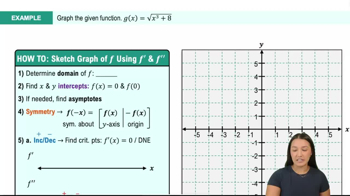Table of contents
- 0. Functions7h 52m
- Introduction to Functions16m
- Piecewise Functions10m
- Properties of Functions9m
- Common Functions1h 8m
- Transformations5m
- Combining Functions27m
- Exponent rules32m
- Exponential Functions28m
- Logarithmic Functions24m
- Properties of Logarithms34m
- Exponential & Logarithmic Equations35m
- Introduction to Trigonometric Functions38m
- Graphs of Trigonometric Functions44m
- Trigonometric Identities47m
- Inverse Trigonometric Functions48m
- 1. Limits and Continuity2h 2m
- 2. Intro to Derivatives1h 33m
- 3. Techniques of Differentiation3h 18m
- 4. Applications of Derivatives2h 38m
- 5. Graphical Applications of Derivatives6h 2m
- 6. Derivatives of Inverse, Exponential, & Logarithmic Functions2h 37m
- 7. Antiderivatives & Indefinite Integrals1h 26m
- 8. Definite Integrals4h 44m
- 9. Graphical Applications of Integrals2h 27m
- 10. Physics Applications of Integrals 2h 22m
5. Graphical Applications of Derivatives
Curve Sketching
Problem 31
Textbook Question
Graphing functions Use the guidelines of this section to make a complete graph of f.
f(x) = x²/(x - 2)
 Verified step by step guidance
Verified step by step guidance1
Identify the domain of the function f(x) = x²/(x - 2). The function is undefined where the denominator is zero, so set x - 2 = 0 and solve for x to find the vertical asymptote at x = 2.
Determine the x-intercepts by setting the numerator equal to zero: x² = 0. Solve for x to find the x-intercept at x = 0.
Find the y-intercept by evaluating the function at x = 0: f(0) = 0²/(0 - 2). This confirms the y-intercept is also at (0, 0).
Analyze the end behavior of the function by considering the limits as x approaches positive and negative infinity. Since the degree of the numerator is greater than the degree of the denominator, the function will have an oblique asymptote. Perform polynomial long division to find the equation of the oblique asymptote.
Sketch the graph using the information gathered: plot the intercepts, draw the vertical asymptote at x = 2, and sketch the behavior near the asymptotes and at infinity, ensuring the graph approaches the oblique asymptote as x goes to positive or negative infinity.
 Verified video answer for a similar problem:
Verified video answer for a similar problem:This video solution was recommended by our tutors as helpful for the problem above
Video duration:
17mPlay a video:
Was this helpful?
Key Concepts
Here are the essential concepts you must grasp in order to answer the question correctly.
Function Behavior
Understanding the behavior of the function f(x) = x²/(x - 2) is crucial. This includes identifying its domain, range, and any asymptotes. The function is undefined at x = 2, which creates a vertical asymptote, and analyzing the limits as x approaches this value helps in understanding the graph's behavior near the asymptote.
Recommended video:

Graphs of Exponential Functions
Critical Points and Extrema
Finding critical points involves taking the derivative of the function and setting it to zero. This helps identify local maxima and minima, which are essential for sketching the graph accurately. Analyzing the first derivative test can also indicate where the function is increasing or decreasing.
Recommended video:

Critical Points
End Behavior
End behavior describes how the function behaves as x approaches positive or negative infinity. For rational functions like f(x) = x²/(x - 2), examining the leading terms helps predict the horizontal asymptote and overall shape of the graph. This understanding is vital for completing the graph accurately.
Recommended video:

Cases Where Limits Do Not Exist

 11:41m
11:41mWatch next
Master Summary of Curve Sketching with a bite sized video explanation from Callie
Start learning




